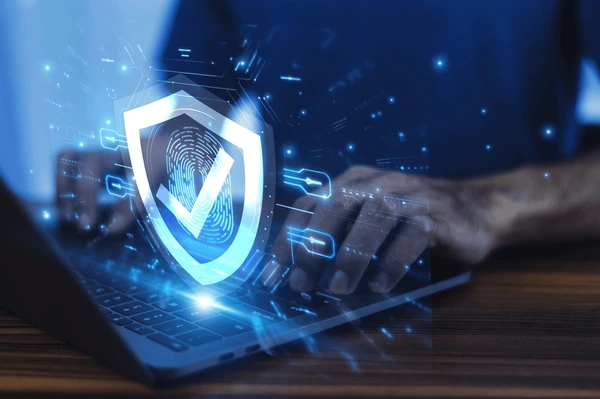
AI isn’t just transforming industries; it’s disrupting the rules of engagement. In cybersecurity, it’s weaponised, decentralised, and accelerating faster than many businesses are prepared for. Organisations still relying on traditional, reactive defences aren’t just lagging behind – they’re becoming prime targets. The time for change is now.
The new era of cyber resilience demands a different mindset. One where AI isn’t just a buzzword in the boardroom, but a strategic imperative woven into operations, culture, and leadership. It’s no longer about “staying secure” – it’s about staying ahead. At Cyberfort, we believe too many businesses are sleepwalking into an arms race already well underway.
AI threats aren’t emerging – they’re already winning
Let’s put this plainly: AI-led attacks aren’t futuristic concepts. They’re happening now. And they’re working. Generative AI is being used to craft phishing emails that are indistinguishable from legitimate correspondence – down to tone, grammar, and visual branding.
We’ve seen real-world cases where attackers impersonated CEOs using deepfake audio to trick CFOs into transferring six-figure sums. AI-coded malware doesn’t just hide, it adapts, mutates, and learns how to beat your systems with each failed attempt. This isn’t theoretical. It’s operational.
If your security strategy is still focused on static detection rules and perimeter firewalls, you’ve already been outmanoeuvred. AI is giving attackers the ultimate unfair advantage: scale and believability. They don’t need to target millions anymore. They can tailor a single, highly effective attack that slips through every layer of your existing defences.
From cybersecurity to cyber resilience – predict, don’t just react
Traditional cybersecurity was built around the idea of reacting: block what you know, respond when you detect. But AI has shattered that model. Reaction is now too slow. The game has changed.
It’s not about “if” you’ll be breached. It’s about how quickly you can see it coming, how fast you respond, and how well you recover. That’s cyber resilience.
Organisations are increasingly adopting AI-powered threat prediction models to stay ahead of evolving cyber threats. Machine learning is being leveraged not just to flag anomalies, but to analyse behaviour over time – who is accessing systems, from where, and how usage patterns change. Effective systems trigger alerts both when activity appears malicious and when it deviates from expected norms.
AI serves as a force multiplier: it reduces noise, increases context, and enables human analysts to focus on the most critical signals. That partnership between human expertise and intelligent systems is essential. Without human intuition, AI can become just automated noise. But human teams without AI – that’s bringing a knife to a gunfight.
The workforce wake-up call: Reskill or risk everything
Let’s make one thing clear – you cannot AI-proof your business without an AI-ready workforce. And no, this doesn’t mean hiring a few data scientists and hoping for the best. It means retraining your entire organisation to operate in a world where seeing is no longer believing, and where digital deception is crafted by algorithms, not amateurs.
Forward-thinking organisations are not just investing in tools, but in their people. This means running deepfake drills, simulating audio impersonation attacks to test how staff respond under pressure – especially when the voice on the line sounds convincingly like their boss.
This isn’t about paranoia. It’s about preparation.
Inclusive, neurodiverse security teams are becoming increasingly important as skills like pattern recognition and lateral thinking are more valuable than ever. People who think differently often perceive threats differently. In cyber defence, seeing what others miss is everything. But here’s the kicker, unless leadership supports this change, meaningful change won’t happen. Which brings us to the next uncomfortable truth.
Leadership – Step up or step aside
The biggest obstacle to true cyber resilience isn’t legacy tech. It’s legacy thinking. Too many boards still treat cybersecurity as a cost centre. Something to insure against, or a compliance checkbox. Meanwhile, attackers are treating it as their primary attack vector.
We’ve seen clients turn this around, but only when leadership got serious. This happens when boards understand that breaches aren’t just technical failures, they’re strategic and reputational crises. When CISOs have a seat at the table, security becomes part of the business strategy, not an afterthought.
AI needs leadership buy-in. Not just funding, but vision. The organisations that will thrive will be those where the C-suite leads by example. They’ll learn how AI works, understand its risks, and champion a culture of security and experimentation. If your leadership team is “waiting to see where the regulations land,” you’re already two years too late.
Challenge everything: This is your mandate
The old rules? Rip them up.
- “Train staff to look for spelling errors” – AI doesn’t make them.
- “Trust what you see and hear” – deepfakes say otherwise.
- “Patch and respond when attacked” – by then, the damage is done.
Challenge everything: your security playbook, your hiring model, your boardroom assumptions, your readiness. Cyber resilience isn’t a goal, it’s a posture – and in an AI-fuelled arms race, it’s your only competitive advantage.
We’re not just facing smarter threats; we’re facing faster ones. Businesses that embrace AI responsibly, retrain their teams radically, and lead from the top will win. The rest will spend the next five years in recovery mode. Technically secure, but reputationally wrecked.
AI isn’t just changing cybersecurity. It’s rewriting the rules of business survival. The question is: are you ready to lead, or are you waiting to follow?





